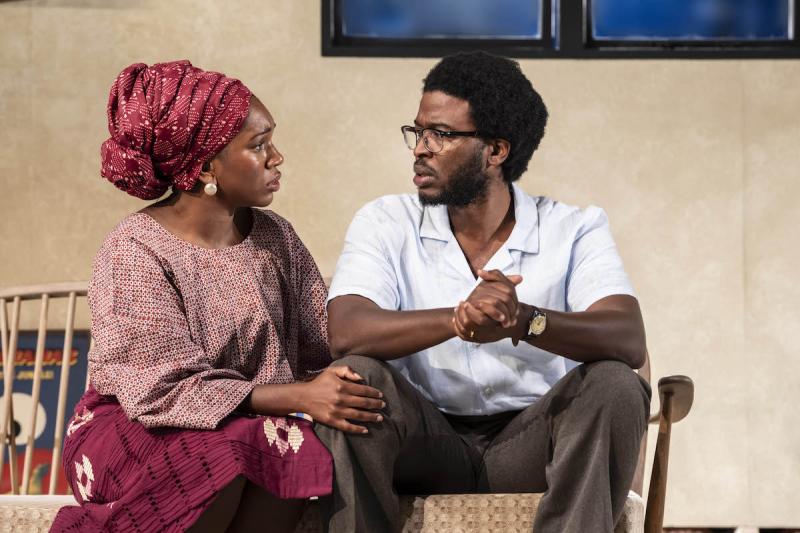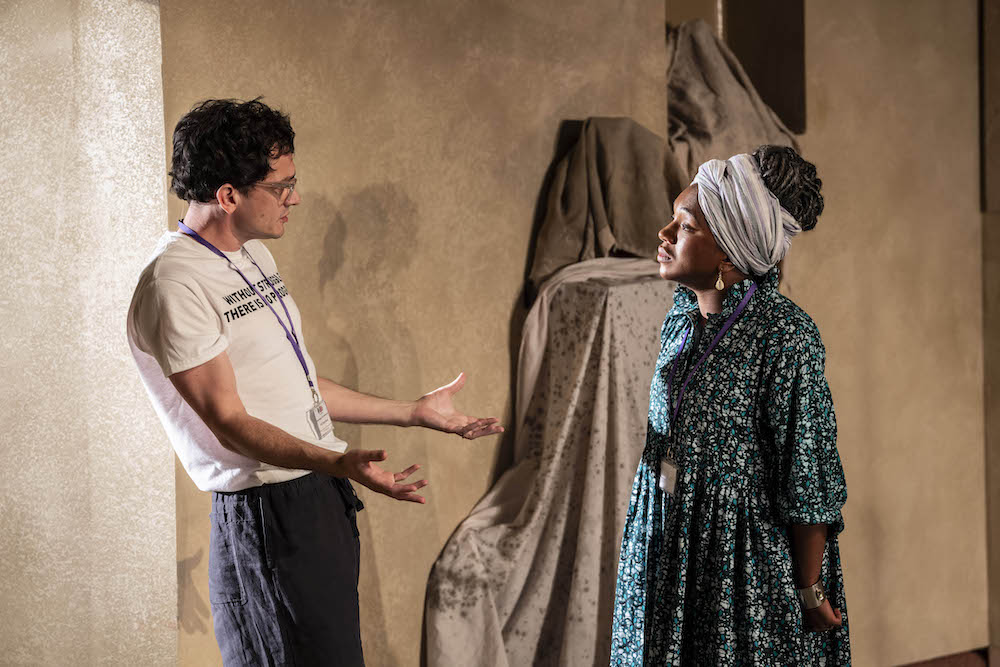Beneatha's Place, Young Vic review - strongly felt, but uneven | reviews, news & interviews
Beneatha's Place, Young Vic review - strongly felt, but uneven
Beneatha's Place, Young Vic review - strongly felt, but uneven
British premiere by this venue’s supremo is thrillingly provocative but also flawed

Trauma is the source of identity politics. In the case of African-Americans, the experience of brutal slavery, exploitative colonialism and violent racism are defining experiences in their history.
Although many recent black dramas have contested this with images of a more celebratory kind of identity, it remains a standard trope, as proved by Kwame Kwei-Armah’s 2013 play, Beneatha’s Place, which he directs himself at the Young Vic, where he is artistic director. In it he channels, among other things, his own experiences of living and working in the United States between 2011 and 2018.
An intertextual tribute to African-American culture, Kwei-Armah’s story is rooted in Lorraine Hansberry’s A Raisin in the Sun, which in 1959 was the first play by a Black woman to be staged on Broadway. In that drama, set in Chicago’s working-class South Side, Beneatha is Lena’s 20-year-old daughter whose dream is to be a medical student despite racial prejudice. When the family is ruined and lose all their money, Joseph Asagai, a Nigerian student, asks Beneatha to marry him and come with him when he returns to Africa. Although Hansberry leaves Beneatha’s choice uncertain, Kwei-Armah lends her a helping hand.
The first act of his story shows Beneatha and Asagai arriving in a white neighbourhood of Lagos in 1959 as the country fights for independence. Initially the tone is hilariously comic as Asagai, now a university professor and political activist, and his medical student wife are introduced to their new home by the ridiculously patronizing and openly racist Alabama missionaries Mr and Mrs Nelson. Just as living in the white neighbourhood of Clybourne Park was a dream for the black family in Hansberry’s play, here it becomes a re-run of the racial confrontations of Bruce Norris’s 2010 piece Clybourne Park.
As the Nelsons depart, comedy turns into something more serious. While Beneatha and Asagai begin to unpack their stuff, which includes his shocking collection of appallingly racist Jim Crow memorabilia, the political situation is sketched out. At one point, his Aunty Fola tells Beneatha that her husband is in a risky position because of tensions within the independence movement. The arrival of white American Daniel, probably a CIA agent, increases the tension. The problem with this flawed act is that the political situation is unclear and, despite some strong insights into American racism of the 1950s, the storytelling lacks impact because it’s hard to see exactly what’s at stake. The play’s second half is stronger and clearer. Although the first half is more about Asagai when really we want to know about his wife, it does provide the trauma that changes her life, and the second act shows her aged 70, a social anthropologist and Ivy League university dean (a chronology unnecessarily muddled by seemingly being set during the pandemic when she would be in her 80s and surely retired). What is thrilling is that Beneatha has returned to her old Lagos home from America, and assembled her academic colleagues – in Nigeria for a conference – to discuss the state of black studies at their institution.
The play’s second half is stronger and clearer. Although the first half is more about Asagai when really we want to know about his wife, it does provide the trauma that changes her life, and the second act shows her aged 70, a social anthropologist and Ivy League university dean (a chronology unnecessarily muddled by seemingly being set during the pandemic when she would be in her 80s and surely retired). What is thrilling is that Beneatha has returned to her old Lagos home from America, and assembled her academic colleagues – in Nigeria for a conference – to discuss the state of black studies at their institution.
This act is much more successful than the first in that there is some real fire in the debate, which is still contemporary, about whether these academics should continue African American studies or instead launch a Critical Whiteness course. Here the play catches fire with provocative comments not only by Beneatha, but also by her white colleagues, such as Mark and Harriet, who want change, and Gary and Wale, a black scion of a petro-rich family, who don’t. Their discussion is rich in ideas and aggressions, both micro and macro.
As they examine the notion of white privilege, the rights of white people to pontificate on race issues, and even to teach black studies, rather than critically examining their own social and cultural advantages, are all issues which are critically grappled with. The idea that black students are no longer interested in the trauma of previous generations and want a much more celebratory notion of race clashes with the experience of racism in both USA and UK. For white students, is guilt now a bore, and how can they support anti-racism without taking a white saviour role? Kwei-Armah offers no easy answers and the play ends quietly as Beneatha, left alone, contemplates her life’s achievements and its losses.
Designed by Debbie Duru, the playwright’s production of his work – which premiered in rep with Clybourne Park at Baltimore’s Center Stage, when he was artistic director there – is powerful, often comic, but also rather static. It’s an uneven play, but this revival features a dignified and commanding central performance by Cherrelle Skeete as Beneatha, who ages convincingly, and is well served by the rest of the cast which play two roles each: Zackary Momoh (Asagai/Wale), Sebastian Armesto (Daniel/Mark, pictured above with Skeete), Tom Godwin (Nelson/Gary) and Nia Gwynne (Mrs Nelson/Harriet). Jumoké Fashola gets some good laughs with her portrayal of Aunty Fola. At its best, the play is a panoramic satire which engages thought-provokingly with Hansberry and Norris.
rating
Explore topics
Share this article
The future of Arts Journalism
You can stop theartsdesk.com closing!
We urgently need financing to survive. Our fundraising drive has thus far raised £49,000 but we need to reach £100,000 or we will be forced to close. Please contribute here: https://gofund.me/c3f6033d
And if you can forward this information to anyone who might assist, we’d be grateful.

Subscribe to theartsdesk.com
Thank you for continuing to read our work on theartsdesk.com. For unlimited access to every article in its entirety, including our archive of more than 15,000 pieces, we're asking for £5 per month or £40 per year. We feel it's a very good deal, and hope you do too.
To take a subscription now simply click here.
And if you're looking for that extra gift for a friend or family member, why not treat them to a theartsdesk.com gift subscription?
more Theatre
 Othello, Theatre Royal, Haymarket review - a surprising mix of stateliness and ironic humour
David Harewood and Toby Jones at odds
Othello, Theatre Royal, Haymarket review - a surprising mix of stateliness and ironic humour
David Harewood and Toby Jones at odds
 Macbeth, RSC, Stratford review - Glaswegian gangs and ghoulies prove gripping
Sam Heughan's Macbeth cannot quite find a home in a mobster pub
Macbeth, RSC, Stratford review - Glaswegian gangs and ghoulies prove gripping
Sam Heughan's Macbeth cannot quite find a home in a mobster pub
 The Line of Beauty, Almeida Theatre review - the 80s revisited in theatrically ravishing form
Alan Hollinghurst novel is cunningly filleted, very finely acted
The Line of Beauty, Almeida Theatre review - the 80s revisited in theatrically ravishing form
Alan Hollinghurst novel is cunningly filleted, very finely acted
 Wendy & Peter Pan, Barbican Theatre review - mixed bag of panto and comic play, turned up to 11
The RSC adaptation is aimed at children, though all will thrill to its spectacle
Wendy & Peter Pan, Barbican Theatre review - mixed bag of panto and comic play, turned up to 11
The RSC adaptation is aimed at children, though all will thrill to its spectacle
 Hedda, Orange Tree Theatre review - a monument reimagined, perhaps even improved
Scandinavian masterpiece transplanted into a London reeling from the ravages of war
Hedda, Orange Tree Theatre review - a monument reimagined, perhaps even improved
Scandinavian masterpiece transplanted into a London reeling from the ravages of war
 The Assembled Parties, Hampstead review - a rarity, a well-made play delivered straight
Witty but poignant tribute to the strength of family ties as all around disintegrates
The Assembled Parties, Hampstead review - a rarity, a well-made play delivered straight
Witty but poignant tribute to the strength of family ties as all around disintegrates
 Mary Page Marlowe, Old Vic review - a starry portrait of a splintered life
Tracy Letts's Off Broadway play makes a shimmeringly powerful London debut
Mary Page Marlowe, Old Vic review - a starry portrait of a splintered life
Tracy Letts's Off Broadway play makes a shimmeringly powerful London debut
 Little Brother, Soho Theatre review - light, bright but emotionally true
This Verity Bargate Award-winning dramedy is entertaining as well as thought provoking
Little Brother, Soho Theatre review - light, bright but emotionally true
This Verity Bargate Award-winning dramedy is entertaining as well as thought provoking
 The Unbelievers, Royal Court Theatre - grimly compelling, powerfully performed
Nick Payne's new play is amongst his best
The Unbelievers, Royal Court Theatre - grimly compelling, powerfully performed
Nick Payne's new play is amongst his best
 The Maids, Donmar Warehouse review - vibrant cast lost in a spectacular-looking fever dream
Kip Williams revises Genet, with little gained in the update except eye-popping visuals
The Maids, Donmar Warehouse review - vibrant cast lost in a spectacular-looking fever dream
Kip Williams revises Genet, with little gained in the update except eye-popping visuals
 Ragdoll, Jermyn Street Theatre review - compelling and emotionally truthful
Katherine Moar returns with a Patty Hearst-inspired follow up to her debut hit 'Farm Hall'
Ragdoll, Jermyn Street Theatre review - compelling and emotionally truthful
Katherine Moar returns with a Patty Hearst-inspired follow up to her debut hit 'Farm Hall'
 Troilus and Cressida, Globe Theatre review - a 'problem play' with added problems
Raucous and carnivalesque, but also ugly and incomprehensible
Troilus and Cressida, Globe Theatre review - a 'problem play' with added problems
Raucous and carnivalesque, but also ugly and incomprehensible

Add comment